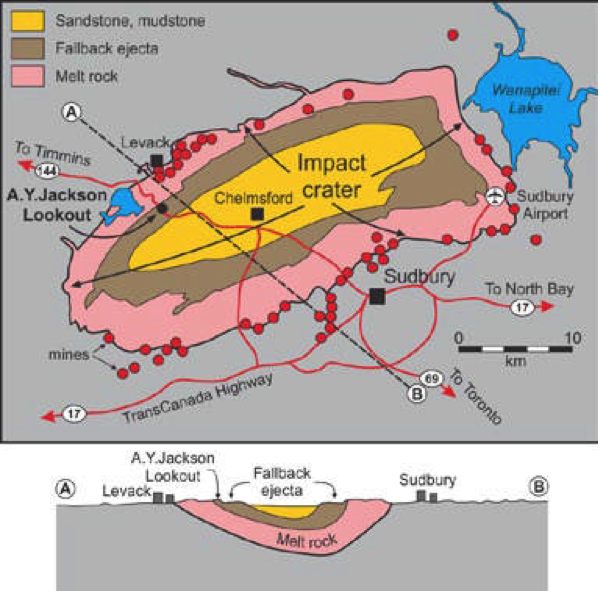Meteorite Impact
The Geological History of the Lake Superior region began nearly 3 billion years ago with the building of a continent, it is still active today as the Earth changes and reforms itself through geologic time. This is the story of our Lake Superior Region extending from these ancient Precambrian (pre-advanced life times) to the present day.

Artists view - NASA & MNDM GeoTours.
Fire & Destruction
Use your imagination to travel back in time 1850 million years ago (B.P.), to the lands near Thunder Bay, Ontario and Northern Minnesota. You would be floating in a boat near the shore of a vast ocean which covered the Lake Superior region. A meteorite believed to be 10 to 16 kilometres in diameter hurtles from space striking the area now known as Sudbury, Ontario (700 kilometres away)! An impact crater 250 kilometres wide is created, which forms the second biggest known crater on our planet (Figure 2). This crater is 50% bigger than the Chicxulub Crater in the Gulf of Mexico, which scientists now believe to have been the cause of the great extinction of the dinosaurs sixty-five million years ago.

Figure 2 - Second Largest Crater on Earth - Sudbury Impact

A 10 -16 kilometre wide meteorite hits the Earth 1.8 billion years ago. A 250 km crater is formed deforming the crust to a depth of 16km.
The impact deforms the Earth's crust to depths of 16 kilometres, allowing nickel, copper, zinc and iron rich magmas to rise from the mantle of the Earth. The mineral rich veins and magmas create the metal deposits which ring the Sudbury area. The force of the collision vaporizes the meteorite and much of the crust. Massive shock waves travel through the Earth causing earthquakes, and ripping apart the rigid iron and silica rich Gunflint Formation rocks near Thunder Bay. The iron and quartz bearing rock is torn into sharp fragments called a "breccia" (photo 8). Within seconds of the impact, a cloud of ash, rock fragments, hot gases, and droplets of molten rock known as "ejecta" rise into the clouds and spread across the globe. As these hot rock fragments start to cool and coalesce, they form concentric spheres of hot rock which fall like hail. These spheres (lapilli) mix with rock literally turned to ashes. This "pyroclastic tuff" looks similar to sedimentary rock, but the presence of the round lapilli proves that it comes from the melted rocks. As the lapilli spheres rain down, they cover the fragments of iron formation like a hot blanket helping to cement the layers together and preserve a record of one of the largest meteorite impacts ever on Earth. Later in geological time the Rove Sea covered the land, and sediments again filter down preserving evidence of the meteor impact beneath a blanket of shale and mudstone.
The following table shows the calculated arrival times and the effects which would be observed at Gunflint Lake, Minnesota; if a similar event occurred today. (From: Minnesota's Evidence of an Ancient Meteorite Impact).
| Arrival Time | Effect | Modern Comparison on our Planet |
| ~13 Seconds | Fireball | 3rd degree burns, trees would ignite |
| ~2-3 Minutes | Earthquakes | Richter scale magnitude 10.2 at Sudbury |
| ~5-10 minutes | Airborne ejecta arrive | A layer 1-3 metres thick, with fragments <1cm |
| ~40 minutes | Air Blast | Maximum wind speeds over 2000km/hr |
| ~1-2 hours | Tsunami | Nothing known of this magnitude on modern Earth |
All of these events happened 1.85 billion years ago. It is a miracle that a record of these events is recorded in a thin layer of rocks less than 8 metres thick, which can be seen across Northern Minnesota and Northern Ontario. This story is told in stones which have survived for almost two billion years (see Figure 3, Photo 8).

Impactite Layer showing rocks shattered 700 km from the meteorite impact site, Thunder Bay. All images courtesy MNDM GeoTours.
Evidence of this impact layer has been located in the Thunder Bay Area by two retired high school teachers backed up by researchers at Lakehead University, and the Ontario Ministry of Northern Development and Mines. The "impactite" rock appears as shattered fragments of the Gunflint Iron Formation and chert (quartz rich cemented in a rusty matrix of volcanic ash). One dramatic example of this rock occurs right in the City of Thunder Bay, in Hillcrest Park.

FIGURE 3, Geologic Column - Showing meteorite impact layer, from: Minnesota's evidence of an ancient Meteorite Impact, Jirsa, Mark - Minnesota Geological Survey
